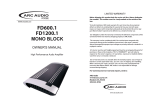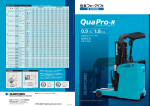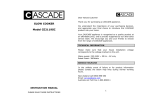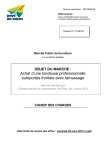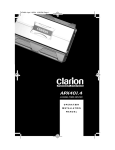Download FD2100 FD2200 FD4100 FD4150
Transcript
FD2100 FD2200 FD4100 FD4150 Congratulations! Thank you for purchasing an ARC Audio Hi-Performance Amplifier. ARC Audio amplifiers are conservatively rated and produce more power per channel than others in there class. Manufactured to the highest standards of quality and reliability to deliver years of listening enjoyment. ARC Audio…SOLID CONSTRUCTION for SOUND Car Audio Systems. Warning We build all ARC Audio products to play at high volumes for extended periods of time. Your ears however are not designed for high volume listening. This product can easily generate volumes that can permanently damage your hearing. We urge you to limit your exposure to very high volume sound. You may also find your state has laws governing the volume of an audio system in a car. Please be aware of all local and state laws in you area. A properly tuned and operated audio system will deliver years of enjoyment when used properly. Installation Instructions ARC Audio FD Series Amplifiers are designed for easy installation in your vehicle. To ensure proper operation of your new purchase, please follow the suggestions we have listed below: Supplying Enough Power The Laws of Nature Your amplifier Does NOT make power. It converts power, or current, from your cars electrical system and turns it into a high power musical energy. If the amp can't get all the power it needs it will not produce its full output. Your ARC Audio amplifier will produce Full output for longer then other amps on the market today. If the Voltage or Current drops too low even our amplifiers will drop below their rated output. Make sure your vehicle charging system is in good working order. Any Hi-Performance audio amplifier will increase the demand on your alternator and battery. If you are unsure have your charging system tested by a professional technician. The Ground!!! Warning: Read this Carefully The ground wire should be connected directly to the chassis of your vehicle. Find a clear location close to the amplifier and remove all the paint and sound deadener. Use a #10 or larger screw to secure it. Never use seatbelt bolts for grounding. Remember, the ground must carry the same high current as the positive power wire. It is recommended in high power application that you upgrade your vehicles factory battery ground lead to the frame and engine grounding points to ensure the best possible circuit to allow you to receive all of the power benefits you new amplifier has to offer. To reduce the risk of noise, run all signal cable from any vehicle or power supply wiring. Warning Please check the suitability of the installation location before you begin. Do not cut any of the car’s structure. Pay close attention to what is behind the panels or carpet. Often the manufacture will hide wires, computers or other electronic devices in the exact areas you wish to install in. Running the Cables Carefully run the power and signal cables through the passenger compartment of the vehicle. Always make sure to use an insulated grommet to prevent the power wire from shorting when passing any cables thru a metal panel and to reduce the risk of fire. Always use the proper size power wiring when installing your new amplifier. Depending on the size of your amplifier a 4 gauge or larger wire should be used for power and ground connections. It is also advised and recommended that a fuse be installed on the power wire within 18 inches of the batter or power source for safety. If you do not have experience with automotive electrical and mechanical systems contact a professional installer. Paying a qualified installer is almost always cheaper then paying a dealership to repair your car. Setting the Gains So you're worried that your 4 Volt output head unit will be too much for the ARC Audio's 2.5 Volt input stage. Don't Be Locating the Amplifier The amplifiers must be securely mounted to a solid surface. Please select a dry location in the trunk or passenger compartment only. Do not mount the amplifier to any area that may have excess vibration (like the subwoofer box). Position the amplifier in an area that receives sufficient airflow for proper heat dissipation. 2 ARC Audio Amplifiers input stage is rated to 2.5 volts RMS @ 1KHz without clipping. Music is very dynamic. Nothing like a 1KHz test tone. It would be rare to see a peak as high as a test tone. Furthermore, your head unit produces its output at full volume but when you tune your system you always set the head unit to 70% of maximum volume. 3 Input Section Because of the wide range of head unit output configurations all ARC Audio amplifiers have an adjustable input sensitivity or “Gain”. The gain is not a volume or a power limiting control like a throttle. It makes the amp more sensitive to input from the stereo. With the gain up the amp will reach full output at a lower volume setting on the deck. At higher gain settings the amp also becomes more sensitive to noise from the car’s electrical system. Try to run the gain at the lowest setting possible for you system. There is no correct gain setting. Because speakers require different power demands to reach the same output, the gains most often need to be used to compensate for these differences. If you tried to set all the gains at half way you would probably find the system didn’t sound very good. Using good judgment and listening carefully to each speaker is still the best way to tune a system. Input Mode Switch All ARC Audio amplifiers include an input mode switch. This switch controls the signal being sent to the amplifier sections. Most 2-channel amplifiers can be bridged into a single channel however if the signal to the channels is not exactly the distortion will increase significantly. The mode switch solves this problem by offering 3 modes of operation. Stereo This is simple 2 channel stereo operation. Use this setting for most applications that do not involve bridging the output. Bridge (R IN) On a 2-channel amp only the Right channel input will be split and sent to both outputs. You need only use the Right gain. On a 4 channel the right RCA will be sent to the front outputs. The left RCA will be sent to the rear outputs. This is a great way of get high power to a component set. The amplifier now acts like a 2 channel that makes full power at 4 ohms. L+R SUM MONO This is the mode for bridging a subwoofer. Both the left and right channels are combined into a mono signal that is then split and sent to both output. This will give you a true mono output. 4 Crossover Controls A crossover is a device that removes unwanted frequencies from a speaker or amplifier. A tweeter can easily be destroyed by bass notes if they are not filtered out. Likewise a subwoofer will not sound natural if it is playing midrange notes. A crossover removes these sounds from the speaker. As you might guess, careful adjustment is need to ensure that all the speakers are playing the right sounds and that you are left with no “holes” or low spots in the frequency response. Bass Boost This amp has a fully adjustable bass boost. Both the frequency and the level of the boost are adjustable. Start with a small increase in the level control. Then “sweep” the frequency up and down. Listen carefully for an improvement in the sound of the bass. If you do not hear any improvement then the woofer does not need any boost. Use Bass Boost carefully. The demands on power output are tremendous. Try to minimize the use by changing woofer position or the enclosure size. Speaker outputs This amplifier is a multi channel amplifier design. Meaning it has more than one channel of speaker outputs. It is equipped with a large block style terminal for speaker connection. Make this connection carefully and neatly. Strip your wire back and twist the exposed leads and insert into the block terminal while being careful that there is no loose or frayed strands of wire and tighten the Phillips head screw down on the terminal till the wire is tightly secured in place. If the wires ever come in contact with each other the amplifier will go into protection. Know your total ohm load before you make any connections. 5 Installation Instructions 1. 9. Connect the speaker wire to the amp and speakers (make sure the amp is off first). Make sure the polarity (+ and-) is correct. 10. Connect the RCA’s to the amp. 11. Double check the amplifier controls at this time. Make sure everything is set correctly for your system. 12. Now you’re ready to play it for the first time. It is best to leave the gain all the way down at first. Start with the head unit volume low and work your way up. 13. Now you can tune the amp. Take your time and make only one adjustment at a time. It may take some time to get the system fully adjusted. During this time the amp is drawing current from the battery. You should check the battery voltage from time to time and re-charge it if it gets low. Battery voltage can affect the way the amplifier performs. 14. You’re done. Now have fun. Disconnect the negative cable from the car battery. Tape up the end so it is isolated form the battery. 2. Run an 8 AWG power wire (4 AWG min. for FD4150 or if you are using multiple amplifiers) from the battery to the amplifier. Plan this part of the installation carefully. This cable will carry very high current. If it should short to the body and it is not properly fused it could catch fire. 3. Connect the power wire to the battery using a fuse capable of the total current load of all amplifiers connected. Don’t install the fuse yet. Wait until the end. Locate the fuse as close as possible to the battery. If the fuse is further that 18 inches (wire length) from the battery you should reevaluate the wire and fuse placement. 4. Find the closest clear metal area to the amp for a ground. Sand, grind or scrape all paint and undercoating from the body and screw the ground securely to the body. It is advisable to test the ground with an ohmmeter between the ground cable and the negative battery cable to insure a good low resistance connection. Some alloys used in modern cars do not offer the best ground. If you believe this is the case consult with the vehicle manufacturer. 5. Run the speaker wire to the speakers. It is advised that you leave some extra wire at this point. You can “clean it up” later. 6. If you haven’t already done so, mount the amp now. 7. Connect the power and ground to the amplifier. Only after this step should you install the fuse at the battery. 8. Connect the remote wire from the head unit to the amplifier. Now is a good time to turn on the amp for the first time. Make sure it turns on properly and does not go into protect. 6 7 FD2100 and FD2200 STEREO FULL RANGE OR HIGH PASS 4 OHMS/2 OHMS FD2100 and FD2200 BRIDGED 4 OHMS Set to LOW Set to HIGH or FULL Set to L+R SUM Set to STEREO 4 0HMS + OPTIONAL SECOND SET 2 OHM STEREO 8 9 FD4100 and FD4150 STEREO FULL RANGE OR HIGH PASS With MONO SUBWOOFER FD4100 and FD4150 STEREO 4 CHANNEL HIGH PASS 4 0HMS + OPTIONAL SECOND SET 2 OHM STEREO OPTIONAL SECOND SET 2 OHM STEREO 10 OPTIONAL SECOND SET 2 OHM STEREO 11 FD4100 and FD4150 STEREO 4 CHANNEL SET BOTH INPUT SWITCHS TO HIGH PASS “BRIDGED” Use the Front inputs, Front gain and Front Crossover only SET BOTH INPUT SWITCHS TO “BRIDGED” FD4100 and FD1500 2 CHANNEL BRIDGED LOW PASS Use the Front inputs, Front gain and Front Crossover only - + 4 0HMS 12 - USE 4 OHM SPEAKERS ONLY WARNING: THE FD4150 WILL PRODUCE 320 WATTS X 2 NOT RESPONSABLE FOR DAMAGED SPEAKERS 4 0HMS + 13 POWER AND INPUT CONNECTIONS DUAL BATTERY or BATTERY AND CAPACITOR SINGLE BATTERY RCA CABLE RCA CABLE POWER AND INPUT CONNECTIONS REMOTE This is a stock ground wire on the battery between the battery and the body. It should be Upgraded to 4 AWG from the factory 8 or 10 AWG. 14 4 AWG. 4 AWG.18” MAX. FUSE 18” MAX. 4 AWG. 4 AWG. FUSE FUSE 18” MAX. Battery or Capacitor 4 AWG. 4 AWG. 18” MAX. 4 AWG.18” MAX. REMOTE Battery Battery This is a stock ground wire on the battery between the battery and the body. It should be Upgraded to 4 AWG from the factory 8 or 10 AWG. 15 Specifications FD4100 4 4 4 2 2 Channels Channels Channels Channels Channels @ @ @ @ @ 4Ohms 2Ohms 1Ohm 4Ohms 2Ohms 50 Watts 90 Watts NOT RECOMMENDED 180 Watts NOT RECOMMENDED FD4150 80 Watts 160 Watts NOT RECOMMENDED 320 Watts NOT RECOMMENDED Frequency Response Crossover Range Bass Boost 20 Hz > 30kHz 55Hz - 550Hz (x10 550Hz - 5500Hz) 0 - 18dB @ 45Hz 20 Hz > 30kHz 55Hz - 550Hz (x10 55Hz - 5500Hz) 0 - 18dB @ 45Hz S/N Ratio (A wtg) ref 1Watt 4Ohm Seperation @ 1kHz Damping (25W 4x4Ohm 100Hz) >95 dB >65 dB >800 >105 dB >75 dB > 1600 Low Level Input Sensitivity Max Peak Current 2Ohm Stereo Dimensions .25V - 2.5V 46A @ 380Watts 10 3/8” X 16 1/2” X 2 3/8” .25V - 2.5V 82A @ 640Watts 10 3/8” X 21 3/4” X 2 3/8” Output Power (RMS) @ .05% 1000Hz 14.4v Input FD2100 2 Channels @ 4Ohms 2 Channels @ 2Ohms 2 Channels @ 1Ohm 50 Watts 95 Watts NOT RECOMMENDED FD2200 100 Watts 185 Watts NOT RECOMMENDED Frequency Response Crossover Range Bass Boost 20 Hz > 30kHz 55Hz - 550Hz (x10 550Hz - 5500Hz) 0 - 18dB @ 45Hz 20 Hz > 30kHz 55Hz - 550Hz (x10 55Hz - 5500Hz) 0 - 18dB @ 45Hz S/N Ratio (A wtg) ref 1Watt 4Ohm Seperation @ 1kHz Damping (25W 4x4Ohm 100Hz) >100 dB >75 dB >800 >98 dB >72 dB > 800 Low Level Input Sensitivity Max Peak Current 2Ohm Stereo Dimensions .25V - 2.5V 28A @ 380Watts 10 3/8” X 13” X 2 3/8” .25V - 2.5V 42A @ 380Watts 10 3/8” X 15 1/2” X 2 3/8” Output Power (RMS) @ .05% 1000Hz 14.4v Input 16 17 Troubleshooting Problem No Audio. Solution Low or no remote turn-on voltage. Check remote connections at amplifier and source unit. Notes It is recommended that you record your system configuration for later use. You may find it helpful to write down your gain and crossover setting . You may also wish to staple a copy of your sales receipt here. Blown amplifier fuse. Replace with new fast-blow fuse (same rating). Power wires not connected. Check battery and ground wiring at amplifier; also check battery connections. Speaker leads shorted. Check speaker continuity to ground, it should not show a common ground. Problem Audio cycles on and off. Solution Thermal protection circuits are shutting amplifier off. Check location for adequate ventilation; consult an authorized ARC Audio Dealer. Problem Distorted audio. Solution Gain is not set properly, or damaged speaker cones. Review Setting Gain; inspect each speaker cone for signs of damage (i.e. frozen cone, burning smell, etc.) Serial Number 18 19










